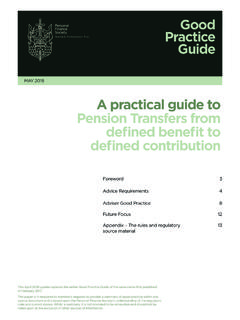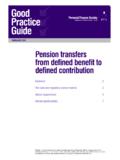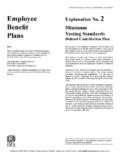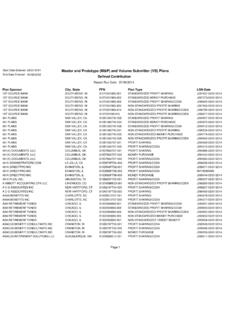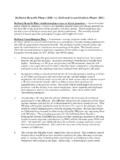Transcription of World Bank Pension Reform Primer Notional accounts
1 World bank Pension Reform Primer This briefing is part of the World bank s Pension Reform Primer : a comprehensive, up-to-date resource for people designing and implementing Pension reforms around the World . For more information, please contact Social Protection, Human Development Network, World bank , 1818 H Street NW, Washington, 20433; telephone +1 202 458 5267; fax +1 202 614 0471; e-mail All Pension Reform Primer material is available on the internet at Notional accounts Notional defined contribution plans as a Pension Reform strategy otional accounts are designed to mimic a de-fined contribution plan, where the Pension depends on contributions and investment returns. (For this reason, they are sometimes called no-tional, defined -contribution schemes). Pension contributions are tracked in accounts which earn a rate of return. However, in Notional accounts , the return that contributions earn is a Notional one, set by the government, not the product of investment returns in the markets.
2 Like traditional social insurance schemes, they are publicly provided. However, the Pension formula differs somewhat from the traditional earnings-related model, with the benefit based on the accumulation in one s account at the time of retirement. Pension accounts in this system are called Notional because there is no pot of Pension fund money, just a series of individual claims on the future public budget. They are pay-as-you-go financed current contributions pay for current benefits just like most defined -benefit public schemes. When the individual reaches Pension age, accu-mulated contributions and Notional returns termed Notional capital are converted to an annuity. By adjusting the annuity rate, the government can adjust the Pension value to take account of life expectancy. Recent reforms in Italy, Latvia, Poland and Swe-den were based on the Notional - accounts model.
3 (The new systems are described in boxes below.) This note assesses the arguments for Notional accounts relative to alternative strategies for Pension Reform . Pension Reform strategies The cost of government promises to pay pensions has been both highlighted and exacerbated by the aging of the population. The scale of these current and projected future commitments has prompted a search for effective Pension reforms. The traditional approach to making public Pension promises more affordable has been to adjust the Pension system s parameters, such as Pension eli-gibility age, indexation arrangements and the rate at which benefits accrue. However, this strategy has often proved unsatisfactory. Benefit cuts have been insufficient to put the Pension system s fi-nances on a sustainable footing. And governments, with their eyes on the short term, have often reversed previous policy changes.
4 A second strategy is to shift some provision to mandatory, funded individual Pension accounts . This model set out in the World bank s report, Averting the Old Age Crisis consists of: a publicly managed system with mandatory participation and the limited goal of reducing poverty among the old; a privately managed mandatory savings system; and voluntary savings. N2 Notional accounts Some 20 countries around the World have now adopted this schema. The main obstacle to re-forms of this type is the transition cost. In simple terms, one generation has to pay for pensions twice: first, for their parents pay-as-you-go enti-tlements and secondly, for their own funded pensions. (See the Pension Reform Primer brief-ing note on transition.) The system of Notional accounts , its proponents argue, offers a third way between these two pro-posals. By maintaining pay-as-you-go finance, Notional accounts avoid the transition costs in-curred by a shift to funding.
5 By mimicking the structure of defined contribution plans, they avoid some of the problems of schemes with a defined benefit formula. Fairness in pensions Linking individual Pension benefits more closely with individual contributions is a central motiva-tion for reforms based on Notional accounts . This enhances the actuarial fairness of pay-as-you-go Pension systems. For example, Edward Palmer, an architect of the Swedish Reform , argues that a fundamental feature of the Notional defined con-tribution system is that it is fair . To explore the fairness issue, we compare Pension entitlements under Notional accounts with a traditional defined -benefit scheme. Notional capital at retirement in a Notional - accounts scheme is the sum of earnings multiplied by the contribution rate. Earnings are revalued by an index, such as the wage bill, which is the no-tional rate of return on contributions to the scheme.
6 This sum is then multiplied by a set con-version factor, often called the g-value . Note that the government sets the value of all the variables: the contribution rate, Notional rate of return and the g-value. In fact, the contribution rate attributed to the Notional account may not even be equal to the contribution rate paid by the contributor, as the experience of Latvia and Italy shows. A defined benefit formula could be similar. Individual earnings, again revalued by an index to take account of changes in the cost or standard of living, are summed over the working life and then multiplied by an accrual factor. The structure is the same. If the revaluation index is the same as for Notional accounts and the accrual rate is equivalent to the g-value multiplied by the no-tional- accounts contribution rate, then the Pension values are the same.
7 There are, however, some differences in practice. The defined -benefit formula in many public pen-sion systems uses the earnings only of a sub-set rather than the full lifetime average. For example, pensions in two-thirds of developing countries and two in five OECD countries are based on some measure of final pay, ranging from the last month s to the last ten years earnings. A further fifth of countries use a limited number of best years earnings. Notional accounts , like the benchmark defined benefit scheme, are based on lifetime average earnings. A second difference stems from changes in the accrual rate with the duration of Pension -scheme membership. Fifty countries public Pension plans pay more for early years contributions (usually the first 10 or 20 years ) than for subsequent contribu-tions. Notional accounts , in contrast, give equal weight to all years contributions .
8 There are strong arguments for basing Pension benefits on lifetime average earnings. First, using a limited number of best or final years dispropor-tionately rewards people with steeply rising pay profiles. These tend to be better-paid careers. Secondly, it opens the system to abuse through people manipulating their reported earnings. Thirdly, it encourages people to retire rather than move to part-time or lower-paid jobs. However, these gains can just as readily be achieved with a defined -benefit scheme based on lifetime average earnings with a constant accrual rate. Indeed, Mr Palmer argues that Notional ac-counts are fair because two people of the same age receive Pension benefits proportional to the amount they pay into the scheme. But this is equally true of many defined -benefit plans. Fiscal sustainability Funded Pension systems avoid many of the prob-lems of financial sustainability by ensuring that Notional accounts 3 there are assets to match Pension liabilities.
9 In a defined -contribution scheme, assets and liabilities match, by definition, at each point in time. In-creased longevity reduces individuals Pension benefits directly, as annuity providers alter the prices they charge. But the cost of any unexpected increase in life expectancy after retirement falls on the annuity companies. Pension liabilities in most pay-as-you-go systems are forecast to rise as a share of national income. This results both from the aging of the population and from increasing generosity of public plans. Fiscal sustainability is generally a central motiva-tion for Pension Reform . But Notional accounts are neither a necessary nor a sufficient condition for improving a Pension system s finances. Sustainability requires real benefit cuts (or, failing that, contribution increases) which are not deliv-ered by a system of Notional accounts per se.
10 More subtly, the Notional - accounts formulae that have been adopted include some automatic stabi-lizers to help sustain the system s finances in the face of adverse demographic or economic shocks. First, the g-factor , the annuity rate set by the gov-ernment, adjusts the Pension benefit to reflect increases in longevity. The system is therefore immune to this aspect of worsening demographics (but not to other changes, such as declining fertil-ity). This means that the Pension replacement rate falls automatically when mortality improves. However, there is no reason why these automatic cuts in benefits will be any easier to achieve in a Notional - accounts system than discretionary cuts would be in a defined -benefit scheme. Nor are Notional accounts necessary for this kind of auto-matic stabilizer. Italy, for example, will in future adjust the replacement rate in its defined -benefit plan every 10 years to reflect increased longevity.










